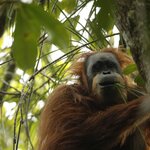Evolution

It sounds gross to humans - unless you read those "Twilight" books in which case maybe it's sexy - but a lot of animals consume blood. That's right, even your cat familiar.
The question is why? Blood is actually a poor source of energy. It consists of 78 percent liquid and what is left is 93 percent proteins and only one percent carbohydrates (1). Blood provides very little in the way of vitamins. Not only that, a blood-based diet exposes animals to blood-borne pathogens.
And yet some bat species (order Chiroptera) feed exclusively on blood and have managed to survive evolution…

How do you miss an organ important for the function of all organs, most tissues and the mechanisms of most major diseases? Easy, you don't look for it.
The interstitium, is under the top layer of skin and also in tissue layers lining the gut, lungs, blood vessels, and muscles. And yet it had never been detected before, because of the medical field's dependence on the examination of fixed tissue on microscope slides, believed to offer the most accurate view of biological reality. Scientists prepare tissue this examination by treating it with chemicals, slicing it thinly, and dying…

In graduate school, I earned beer money by modeling for life drawing classes in various art departments. (Don’t judge, grad school doesn’t pay well and beer isn’t free.) In the long hours standing around, I would survey the room and count how many of the aspiring artists were left-handed. Later in my career, I did the same thing — counting lefties, not standing around naked — in the biology classes I taught.
Funny thing, in any given class, around 10 per cent of the students were lefties. It turns out this is true for all human populations, not only middle-America university classes.…

Move over, Bornean and the Sumatran orangutans. Scholars have identified a third orangutan species, the Tapanuli orangutan, that sits alongside the Pongo abelii, living on the island of Sumatra, and the Pongo pygmeaeus, endemic to Borneo, on the evolutionary tree.
This third species was known since 1997, found in Batang Toru, a region within the three Tapanuli districts in North Sumatra, but the first indications of the uniqueness of the Tapanuli population came from the skeletal material of an adult male orangutan killed in 2013 - when compared to other skulls it turned out that certain…

In determining the gender of offspring, fathers may be getting shortchanged.
Because mothers can influence their offspring in a number of ways, from copulation to birth, while fathers have control over sperm only, it has long been assumed mothers are more important. In mammals, it is also believed that offspring sex ratios can only be determined by the mother, since fathers have always been thought to inseminate an equal proportion of X and Y sperm, having a random effect on offspring sex that they could not shift from equality, or 50:50.
Not so, according to a new paper in Proceedings…

It won't matter if all the ice melts and seas rise 100 feet, even if frogs rain from the skies and dogs and cats are living together, one species will be around until the sun explodes.
That species is the eight-legged micro-animal tardigrade, the world's most indestructible species.
The water bear, as it's called, will survive the risk of extinction from all anthropogenic and astrophysical catastrophes, and be around for at least 10 billion years - probably far longer than the human race. Why? Once life emerges, it is surprisingly resilient and difficult to destroy, and tardigrades are…

Ah, life is good lately; can’t stop winning. Almost never recommend anybody, ‘cuz humans disappoint, but if I do, its winners. Remember that “Erectus walks among us” guy with his “Out of Europe” theory? Yep – that’s the one I recommended, the most despised of the low. I only recommend those who are near my level. Well, ok, that orange fat disappoint I endorsed for POTUS is obviously not anywhere near my level, but that’s another story – I knew he would win and I just love to “Told’yer so!”
Anyway, as a scientist who actually appreciates the scientific method – I know, silly loser right –…

The oldest-known primate skeleton, 62-million-years-old, dwelled in treetops, not on the ground, according to a new analysis.
The study shows that Torrejonia, a small mammal from an extinct group of primates called plesiadapiforms, had skeletal features adapted to living in trees, such as flexible joints for climbing and clinging to branches. Previously, researchers had proposed that plesiadapiforms in Palaechthonidae, the family to which Torrejonia belongs, were terrestrial based on details from cranial and dental fossils consistent with animals that nose about on the ground for insects.
The…

We are at the top of the food chain, but some of our senses got short shrift when it came to other animals. Dogs can hear at frequencies we can't, mantis shrimp got 16 visual pigments and we are stuck with just 3.5, and don't even get other animals started on our pathetic sense of smell.
But a weak nose in humans is really just a 19th century myth that won't go away, like homeopathy and organic food, according to a new analysis. Instead of being limited to a paltry 10,000 odors, humans can discriminate maybe one trillion different ones, the same as dogs and rodents. The faulty…
A few days ago I read an article in the Telegraph Humanity’s earliest known ancestor discovered - and it looks like a ‘wrinkled old sack’, featuring this creature: namely Saccorhytus, a newly discovered microfossil from the Lower Cambrian of Shaanxi province, China, making it 540 million years old. Here is a scanning electron micrograph of the actual fossil: The Telegraph article quotes the senior author Simon Conway Morris as saying
“All deuterostomes had a common ancestor, and we think that is what we are looking at here.”
But about the same time I…